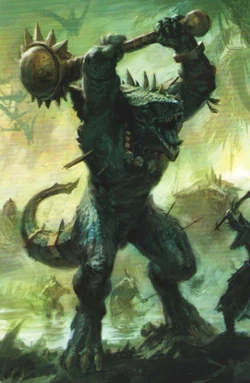I'm a bit late to this, but I really enjoyed the concept of Le Chaudron Chromatique's Island and Random Encounters Speciation Table, so I finally got around to doing one myself. This is rather time consuming, it would be nice to come up with a faster way to do this (maybe one day I'll do a javascript version if I ever get back to doing that kind of stuff). I chose to use the Old-School Essentials (OSE) Wilderness Encounter Tables, specifically the Lake, River section. It was surprisingly robust for this purpose. I do think that bestiary is very basic, but for the purposes of something like this it works well. I might want to do another one some day though with a weirder bestiary, like Numenera or Gamma World. That being said, I think if it were too weird, the speciations might seem too arbitrary to be interesting. But I would like to find a way to inject a little bit more Weird into this. But for now, I'm happy with this.
I would also potentially like to flesh these species and this setting out further, but alas, just writing this up took a while, so I'm just going to roll with it as is. I think it's pretty cool, but with a little bit of Weird & Wonderful personal touch it could be even cooler.
Initial Environment:
- Lizard Person
- Water Termite
- Giant Shrew
- Nixie
- Killer Bee
- Sturgeon
- Large Crocodile
- Hobgoblin
- Driver Ant
- Fire Beetle
- Panther
- Giant Scorpion
- Crab Spider
- Gold Dragon
- Boar
- Thoul
- Giant Leech
- Black Widow Spider
- Human
- Basilisk
Adaptation and Speciation:
- Lizard Person (Hyper HD)
- Water Termite (Saves)
Giant Shrew(Nixie)- Nixie (Dwarf)
- Killer Bee (Hyper Morale)
Sturgeon(Black Widow Spider)- Large Crocodile (Hoarder)
- Hobgoblin (Giant)
Driver Ant(Large Crocodile)Fire Beetle(Nixie)Panther(Basilisk)Giant Scorpion(Lizard Person)Crab Spider(Nixie)- Gold Dragon (Dwarf)
- Boar (Stunted Hoarder)
Thoul(Basilisk)Giant Leech(Hobgoblin)- Black Widow Spider (Attack Type)
Human(Large Crocodile)- Basilisk (Giant)
Final Table:
It seems like Nixies and Crocodiles were perhaps the two biggest winners in this evolutionary history. The nixies in particular I'm happy about since they bring a bit of magic and weirdness to this setting, but the idea of crocodile ants is also intriguing. If I were to put my Weird & Wonderful touch to this I'd probably collapse the basilisks, dragons, crocodiles, and maybe even lizard people into a shared origin. Some of the species seem a bit redundant, like the Lizard People and the Basilisk People, and to a lesser extent the giant hobgoblins, although they arguably take on more of a troll-like niche. We'll see, hopefully I'll come back to this.
Warhammer Kroxigor. Not quite what I have in mind for the Sapient Crocodiles but they're cool.
- Dire Lizard Person (++HD)
- Fortitudinous Water Termite (+Poison Save)
- Giant Burrowing Nixie (Tanuki-like Nixies that shapeshift into a Giant Shrew form)
- Misty Nixie (microscopic Nixies that cluster into gas-like mist; more like fungus or bacteria than animal)
- Dire Killer Bee (++Morale, known for being hyper-aggressive)
- Black Widow Fish (Sturgeon-shaped, chitinous, swimming black widow spiders, look kind of like horseshoe crabs. Poisonous)
- Large Dracodile (Large Crocodile that has evolved pseudo-dragon characteristics as a form of intimidation, including hoarding behaviors)
- Giant Hobgoblin
- Crocodile Ant (Hive-minded micro-crocodiles)
- Burrowing Nixie (Like Giant Burrowing Nixies but regular-Nixie sized, and bio-luminescent)
- Climbing Basilisk (Smaller and softer-skinned than regular basilisks, but faster, more agile, capable of climbing, more willing to fight up close. Weaker / less reliable stare powers)
- Spitting Lizard Person (Feral lizard people with hardened skin and venemous close-range spit)
- Weaver Nixies (Climb, produce mucous-like "silk" from river water, decomposition, and magic)
- Dwarf Gold Dragons (They lost the position of Apex Predator from the Basilisks, as they were too big and caloric to be sustainable in this ecosystem. Why didn't they leave?)
- Ravished Boar (Creepy skinny bony boars with odd and counterproductive behaviors; barely eat or make any effort to sustain themselves. Some weird genetic mutation; probably on the way to extinction)
- Basilisk Person (Humanoid basilisks with sub-human cognition but powerful basilisk strength and abilities. May eventually become the army of a Dark Lord)
- Vampire Hobgoblins (Mer-Hobgoblins with leech-like mouths)
- Black Widow-Maker Spider (Black Widow Spiders with venom that is explosive rather than neurotoxic)
- Sapient Crocodile (Large crocodiles that have evolved human-level intelligence and have developed a civilization equivalent to late stone age or early bronze age humanity. They utilize tools and weapons with prehensile hands and their mouths. They trade with other intelligent species from beyond their local ecosystem.)
- Giant Basilisk (They won over the Apex Predator position from the Gold Dragons, who were too big and caloric to be sustainable in this ecosystem)

LCC's whole speciation trend/game/tool is fascinating to me. A big part of what got me into this whole thing was Dougal Dixon's The Future is Wild. Don't even know how many times I took that one out from the library. Feel there's still depths to be plumbed down it.
ReplyDeleteRolling back on myself here, maybe because life itself is an expression of deep time with natural history involved, maybe because the shallow future stares us in the face when we look at life now. A thematically rich toy in any case.
DeleteI haven't actually read any of the Dougal Dixon books but I've seen some of the art and it seems fascinating. I agree that there's something about how evolution- adaptation and speciation, shows the relationships between organisms and the mechanisms of them, that is in some ways very elegant and in others very clumsy and ad hoc, that makes it so creatively and intellectually appealing.
Delete